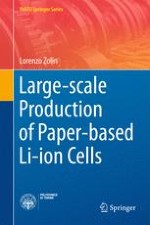2017 | OriginalPaper | Chapter
5. Electrode Preparation Exploiting Filtration
Author : Lorenzo Zolin
Published in: Large-scale Production of Paper-based Li-ion Cells
Publisher: Springer International Publishing
Activate our intelligent search to find suitable subject content or patents.
Select sections of text to find matching patents with Artificial Intelligence. powered by
Select sections of text to find additional relevant content using AI-assisted search. powered by
